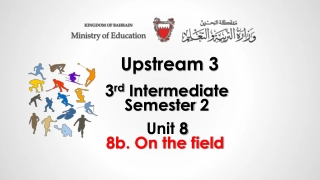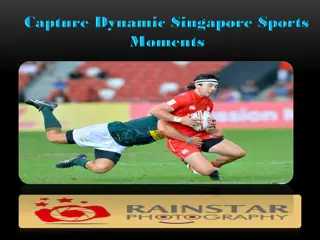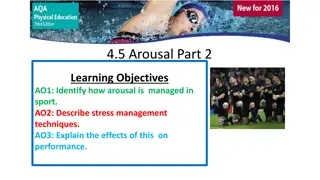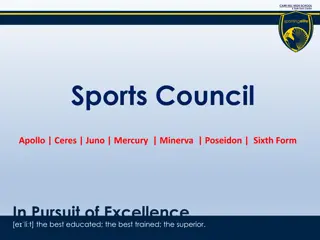Understanding Periodisation in Sports Performance
Proper planning and development are crucial for maximizing athletes' potential in sports. Periodisation is the planning process that helps optimize training components and lead to peak performance while avoiding overtraining. Linear, undulating, and conjugative periodisation are common approaches used to progress training stress and fitness characteristics. By following a periodised approach, athletes can sequentially develop attributes over time for long-term success at the elite level.
Download Presentation

Please find below an Image/Link to download the presentation.
The content on the website is provided AS IS for your information and personal use only. It may not be sold, licensed, or shared on other websites without obtaining consent from the author. Download presentation by click this link. If you encounter any issues during the download, it is possible that the publisher has removed the file from their server.
E N D
Presentation Transcript
In terms of sports performance, that means if you fail to plan the development of your athletes properly, you will not be able to maximize their potential. The planning process in sports is called "Periodization". Maj(R)S.Maniam
By the end of this workshop, you should have an understanding of the following: What,Why, When and How of Periodisation 1. The Phases and Cycles in Periodisation 2. Meaning and use of Tapering , Transition and Peaking Index 3. How all above is used to formulate an Annual Squash Plan 4. Maj(R)S.Maniam
To compete at the elite level squash players require to develop and be proficient in a range of attributes. Ideally players use a periodised approach to training for optimal long-term development, which allow them to sequentially develop these attributes over a desired period of time
Periodisation is the art and science of planning and integrating all training components (technical, tactical, physical and psychological) along with social factors (sleep, nutrition, hydration, drug education, career guidance) Into a sequence that will optimize the development of an athlete and lead to peak performance at the desired time, while avoiding plateau and overtraining. In a nutshell it means when and what type of stress you place on the body Maj(R)S.Maniam
CLASSIC LINEAR PERIODISATION UNDULATING PERIODISATION CONJUGATIVE PERIODISATION Maj(R)S.Maniam
Progressing a training stress or fitness characteristic in a linear fashion. This is roughly equivalent to progressive overload for single or multiple factors. Normally concentrating on one motor ability per phase without changes in exercise. Any change from one session to the next is some form of progressive overload. More weight on the bar, more reps, more sets, etc. Progress with more weight with the same number of reps, or more reps with the same weight. Maj(R)S.Maniam
Changing the training volume and/or intensity to expose the body to different stressors. Weights, reps, and sets can change day to day and week to week, but there are normally no changes in exercises, and the overall average volume and intensity remains the same. Maj(R)S.Maniam
Regularly changing training stressors (exercises) with the purpose of training different physical characteristics (like maximal strength and explosiveness, for example) simultaneously. There is no one-size-fits-all best training plan, but almost all successful training plans have all three of these elements linearity, conjugation, and undulation
Microcycle 5-7 days. Normally a week Mesocycle Major training phase within a year (4-6 weeks) Normally a month Macrocycle A training year It refers to the overall training period, usually representing a year or two. There are longer cycles as well for the Olympian, being 4 or 8 years.
Preparation Period General Preparation Phase Specific Preparation Phase Competition Period Pre-Competition Phase Competition Phase Transition Period Transition Phase Rest and Recovery
General Preparatory Phase Rehabilitation from existing injury Structural development Fitness foundation with cross-training General Aerobic Endurance General Strength Strength Endurance Speed Skill Building development Varied technical practice
Specific Preparatory Phase General Aerobic Endurance Special Endurance Sub-maximal speed endurance General Strength Speed Strength Strength Endurance Speed Skills/Coordination Sport-specific fitness and training
Pre-Competition Lactate Training (if appropriate) Taper High intensity/low volume Competition simulation Competition Maintenance of the components of performance High intensity/very low volume Focus on mental skills
Maintain fitness 30-50% of competition load Mental and Physical Rest Career/Education Screenings Physical Psychological Career/Education Possibly fitness testing? Review year Goal setting
Pre- General Specific Competition Preparatio n Preparation Phase Main Competitions Preparation Phase Competition Phase Volume Intensity Athletic Shape
PERCEPTUAL MOTOR SKILLS PSYCHOLOGICAL SKILLS PHYSIOLOGICAL SKILLS LIFE SKILLS
RALLY BUILDING AND MOVEMENT SKILLS IN A RALLY TACTICAL DRILLS (SIMPLE AND PRESSURE SESSIONS) SESSION WITH COACH (SIMPLE AND PRESSURE SESSIONS)
TACTICAL GAMES DECEPTION AND DECISION MAKING PERFORMANCE ANALYSIS DIAGNOSTIC CLOCK FOR NOTATIONAL AND VIDEO CONDITIONED GAMES MATCH OVERLOAD AND MATCHPLAY COMPETITION
GOAL SETTING AND MOTIVATION RELAXATION VISUALISATION AND IMAGERY BREATHING TECHNIQUES COPING WITH STRESS FOCUSSING SELF- TALK
COMPONENTS: Aerobic Anaerobic Strength general, hypertrophy, endurance, maximum, power Flexibility Agility Balance Core stability Co-ordination Reaction and Response Time (HickS-LAW)
Nutrition Athlete Career Guidance Athlete Education Guidance Rest and Recovery Patterns Drugs Counselling Habits
GPP SKILL BUILDING Error Diagnosis (Diagnostic-Clock) & PDA Correction Learning of new skills GPP SKILL BUILDING Movement Biomechanics & Styles TACTICAL SKILLS Game styles Video Analysis - Understanding different game plans TACTICAL SKILLS Maj(R)S.Maniam
PERCEPTUAL MOTOR Open drills Anticipation Perception - Deception Pressure Drills Movement skills when under pressure Performance Analysis Diagnostic Clock player and opponent matches PERCEPTUAL MOTOR SKILLS Maj(R)S.Maniam
PERCEPTUAL MOTOR SKILLS Conditioned Games Game plans Match overload Match play Test matches Video Analysis - Maj(R)S.Maniam
PERCEPTUAL MOTOR SKILLS Conditioned Games Game plans Match overload Match play Test matches Video Analysis Diagnostic Clock Maj(R)S.Maniam
GPP Aerobic Build-up GPP General Strength Hypertrophy Fitness Test Maj(R)S.Maniam
Speed and Agility Speed and Strength Endurance Maximum Strength Power Conversion Plyometrics Fitness Test Maj(R)S.Maniam
Lactate Training (Tabata type activity) Speed and Agility (High Intensity, Low duration) Tapering Mileage less is more - Training Intensity more is more Maj(R)S.Maniam
GPP Introduction to the skill (Explain concept) Development of the skill in a quiet setting SPP Incorporation of the skill in sport specific situation (Specific Refinement of the skill in training and in preparatory competition COMPETITION Integration of the skill in strategies of Use of the skill in competition to achieve IPS GPP SPP Incorporation of the skill in sport specific situation (Specific application) Refinement of the skill in training and in preparatory competition COMPETITION Integration of the skill in strategies of competition Use of the skill in competition to achieve IPS application) competition Maj(R)S.Maniam
PHASES/ COMPONENTS PREPARATORY COMPETITION GPP SPP PRE-COMP COMP PERCEPTUAL MOTOR SKILLS Maintain Video Reviews Error Correction PDA Learning of new skills Basic Skills Movement Game styles Video Analysis - Understanding different game plans Open drills Deception and Anticipation Pressure Drills Movement Skills Video Analysis player and opponent matches Conditioned Games Game plans Match overload Match play Test matches Video Analysis PHYSICAL Aerobic Build-up General Strength Hypertrophy Fitness Test Maintain Speed and Agility Speed Endurance Maximum Strength Power Conversion Plyometrics Fitness Test Lactate Training Speed and Agility (High Intensity, Low duration Strength Endurance PSYCHOLOGICAL Incorporation of the skill in sport specific situation (Specific application) Refinement of the skill in training and in preparatory competition Integration of the skill in strategies of competition Use of the skill in competition to achieve ISP Introduction to the skill (Explain concept) Development of the skill in a quiet setting Maj(R)S.Maniam
CLASSIFICATION OF YEARLY COMPETITION SCHEDULE Peaking Index 1 competition day. ladder matches. Peaking Index 2 competition day) CLASSIFICATION OF YEARLY COMPETITION SCHEDULE Peaking Index 1 - - NO EMPHASIS Training continues as usual. May train on e.g. local leagues, local club competitions, NO EMPHASIS Peaking Index 2 - - MINOR EMPHASIS Taper period 1 day. (Generally no training on Active rest/recovery 1 day Total 1 2 days (slightly disrupted training) e.g. local competitions MINOR EMPHASIS
Peaking Index 3 Peaking Index 3 - - First Minor Peaking Competition Taper period 2-4 days Active rest/recovery 1-4 days Total 5-7 days disrupted training e.g. national championships, test matches First Minor Peaking Competition Peaking Index 4 period) e.g. international open events, selected PSA, WISPA events. Peaking Index 4 - - First Major Peaking Taper period - 4-10 days. Active rest/recovery 5-7 days Total 9-17 days (not including competition First Major Peaking
Peaking Index 5 including competition period) e.g. the Olympics, World championships, Asian championships, Asian Games The star rating level is dependant on the competition level. Peaking Index 5 - - Most Important Yearly Peak Taper period 14-21 days Active rest/recovery 4-12 weeks Total 6-15 weeks disrupted training (not Most Important Yearly Peak
Step 1: Identify the major events that the athletes must peak for. Include any important dates in the plan including training camps, school holidays and exams. Step 2: Work chronologically backwards from this date outlining the weeks and months to the current date. Step 3: Divide the plan into three major training phases of a training plan (preparation - (GPP, SPP), pre-competition, and competition) Maj(R)S.Maniam
Step 4: Break each phase into the desired messo cycles and micro cycles incorporating appropriate loading and unloading (recovery) periods. A general recommendation is to have a four-week messo cycle where you have three weeks of loading followed by one week unloading or recovery. Step 5: Determine target training load percentages for each phase. Step 6: Incorporate a method of monitoring the progress of the athletes into the plan, e.g. time trials, fitness tests, game rehearsals etc. Maj(R)S.Maniam
Step 1: Identify which phase the particular week occurs in and observe the target training load percentages for that phase Step 2: Observe the time, distance or performance target for that week Step 3: Determine the time and/or distance for each training zone for that week Step 4: Select the suitable training protocols to achieve these training goals " Step 5: Record and monitor your plan Maj(R)S.Maniam
ANNUAL PLAN MONTHS JAN FEB MAR APR MAY JUN JUL AUG SEP OCT NOV DEC DATES WEEKENDS7 14 21 28 4 11 18 25 4 11 18 25 1 8 15 22 29 6 13 20 27 3 10 17 24 1 8 15 22 29 5 12 19 26 2 9 16 23 30 7 14 21 28 4 11 18 25 2 9 16 23 30 C A L E N D A R O F E V E N T S LOCAL FOREIGN TRAINING PHASE P A R A M E T E R S STRENGTH T R A I N I N G ENDURANCE SPEED TECHNICAL TACTICAL PSYCHO MACRO CYCLE 1 2 3 4 5 6 7 8 9 10 11 12 MICRO CYCLE 1 2 3 4 5 6 7 8 9 10 11 12 13 14 15 16 17 18 19 20 21 22 23 24 25 26 27 28 29 30 31 32 33 34 35 36 37 38 39 40 41 42 43 44 45 46 47 48 49 50 51 52 PEAKING INDEX FITNESS TEST MEDICAL TEST TRAINING CAMPS VOLUME ------- P 5 INTENSITY E 4 PEAKING A 3 K 2 1 GENERAL The follwowing activities should be encouraged on a regular/daily basis: 1. Breathing exercises 2. Relaxation and visualisation 3. Stabiliser exercises 4. Sit-ups and push-ups STRENGTH PHYSICAL Aerobic Endurance Anaerobic Lactate Recovery Training Plyometric Speed & Agility Recovery Week TACTICAL Anticipation & Deception Conditioned Games Video Analysis Shot Selection Coping with different types of play TECHNICAL Error Correction Solo Session with coach Pressure Drills Conditioned Games Match Overload & Matchplay PSYCHOLOGICAL Goal Setting and Motivation Breathing and Concentration Positive Self Talk Relaxation and visualisation Coping with anxiety Distraction Management Reps 8-10 4-6 6-8 30-40 Sets 1-2 3-5 2-4 1-2 %RM 50-60% 75-85% 60-70% 55-65 General? Strength? (AA) Max? Str Power/Conversion Strength? Endurance Maj(R)S.Maniam
Periodisation is best thought of as a way of organising your long term training towards an eventual goal for improved performance of hitting a peak on a particular date. If you want to build the best all round performance, some form of periodisation will undoubtedly form the bedrock of your training scheme.
THANK YOU Maj(R)S.Maniam























